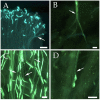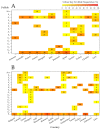Self-Incompatibility in Apricot: Identifying Pollination Requirements to Optimize Fruit Production
- PMID: 35956497
- PMCID: PMC9370128
- DOI: 10.3390/plants11152019
Self-Incompatibility in Apricot: Identifying Pollination Requirements to Optimize Fruit Production
Abstract
In recent years, an important renewal of apricot cultivars is taking place worldwide, with the introduction of many new releases. Self-incompatible genotypes tolerant to the sharka disease caused by the plum pox virus (PPV), which can severely reduce fruit production and quality, are being used as parents in most breeding programs. As a result, the self-incompatibility trait present in most of those accessions can be transmitted to the offspring, leading to the release of new self-incompatible cultivars. This situation can considerably affect apricot management, since pollination requirements were traditionally not considered in this crop and information is lacking for many cultivars. Thus, the objective of this work was to determine the pollination requirements of a group of new apricot cultivars by molecular identification of the S-alleles through PCR amplification of RNase and SFB regions with different primer combinations. The S-genotype of 66 apricot cultivars is reported, 41 for the first time. Forty-nine cultivars were considered self-compatible and 12 self-incompatible, which were allocated in their corresponding incompatibility groups. Additionally, the available information was reviewed and added to the new results obtained, resulting in a compilation of the pollination requirements of 235 apricot cultivars. This information will allow an efficient selection of parents in apricot breeding programs, the proper design of new orchards, and the identification and solution of production problems associated with a lack of fruit set in established orchards. The diversity at the S-locus observed in the cultivars developed in breeding programs indicates a possible genetic bottleneck due to the use of a reduced number of parents.
Keywords: Prunus armeniaca; S-alleles; apricot; pollen tube; pollination; self-incompatibility.
Conflict of interest statement
The authors declare no conflict of interest. The funders had no role in the design of the study; in the collection, analyses, or interpretation of data; in the writing of the manuscript, or in the decision to publish the results.
Figures



References
-
- Janick J. The Origin of Fruits, Fruit Frowing and Fruit Breeding. Plant Breed. Rev. 2005;25:255–320. doi: 10.1002/9780470650301.ch8. - DOI
-
- Faust M., Surányi D., Nyujtó F. Origin and Dissemination of Apricot. Hortic. Rev. 1998;22:225–266. doi: 10.1002/9780470650738.CH6. - DOI
-
- FAOSTAT. [(accessed on 24 June 2022)]. Available online: http://www.fao.org/faostat/es/
Grants and funding
LinkOut - more resources
Full Text Sources
Research Materials

